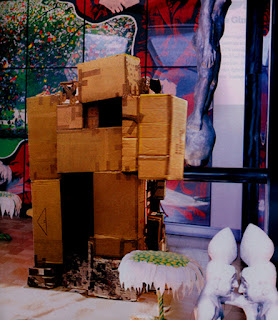Domestic everyday landscapes and the things that occupy
them inspire me. I draw from childhood memories as a
means to construct a narrative that explores identity, scale, status and
inadvertently politics.
I am drawn towards objects in environments that have
ambiguous or multiple meanings. I am after a flexible art that devours itself:
forever a fairy castle to the hopeless drunk inside.
In research by Maria Kylin through the Department of Landscape Planning, at the Swedish University of Agricultural Sciences, on children’s dens and forts, she outlined that most of the children who made dens did so out of a basic compulsion to create a secret or private space, where they could act out and explore group and individual identity. My practice heeds to these desires and reflects a basic human necessity for space, identity and boundaries.
My sculptural work is also a personal reference to my
early childhood in South
Africa in the late 1970's to the early 1980's
The cardboard constructions also act as a safe haven, away
from the hustle and bustle of contemporary life. The experience of being inside the
box sculpture is quite unique and has, in the past, invoked strong emotion in a
number of the viewing public. The sensation I get is that of security and
warmth, and strangely almost a return to the womb. This notion sits uneasily with the crude
visual aspect.
The work’s meaning change depending on the viewer’s position and I am particularly interested in this ebb and flow.
The work’s meaning change depending on the viewer’s position and I am particularly interested in this ebb and flow.
The sculptures are made with recycled cardboard,
corrugated plastic, paper, plastic sheeting, packing tape and occasionally
paint. I like the utilitarian quality of cardboard and the fact that it can be
easily found on street corners and behind buildings. Recycling materials is an
important aspect in my work; I am fascinated by the notion that what once began
as one thing can metamorphose into something completely different.
 |
|
If you stay in your hiding place long enough, you will stop hiding and
you will become that place.
|
 |
|
A childlike exploration of mortality:
slipping between the hide and seek of fragility and bravado.
The words
of May Swenson rang in my ears “We play in the den of the Gods and snort at
death.”
|
 |
My den is ephemeral, a dance of shadows and a hiding place for dreams.
|






